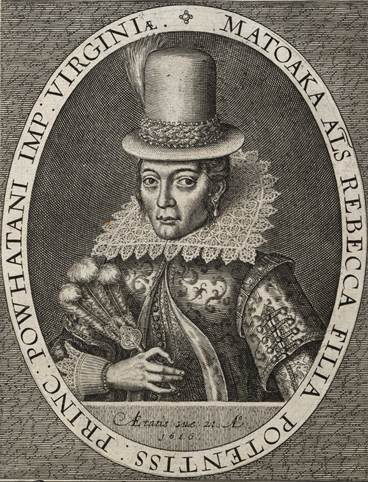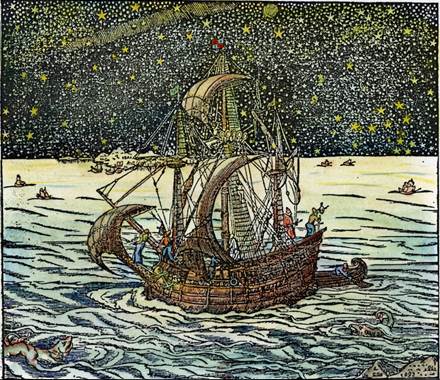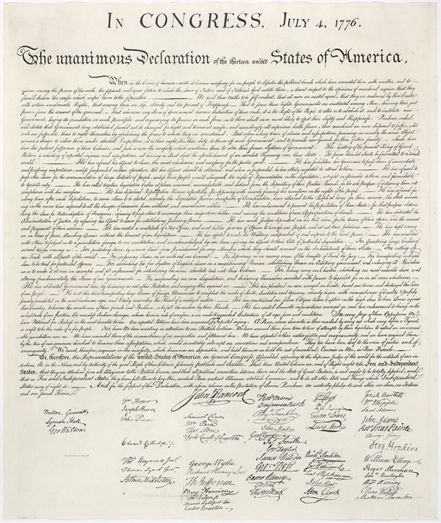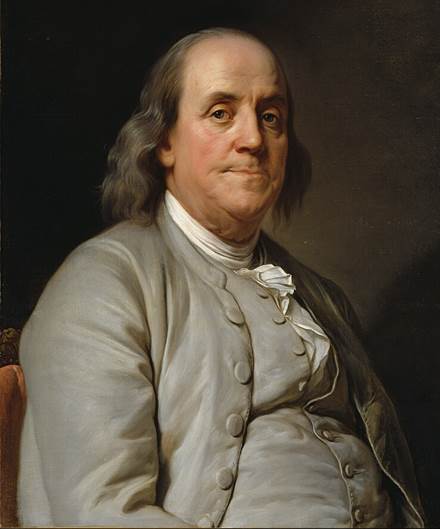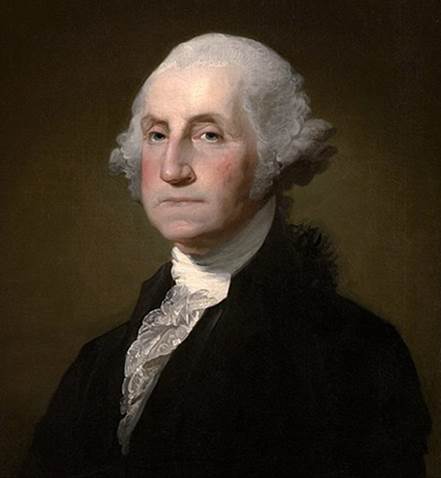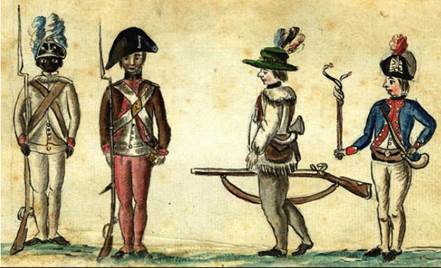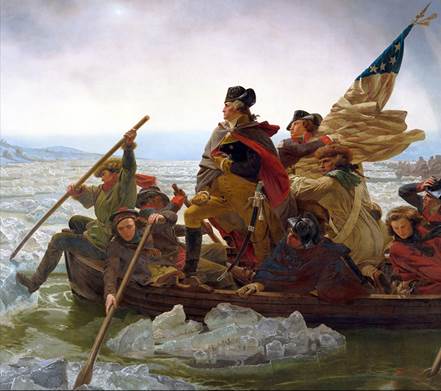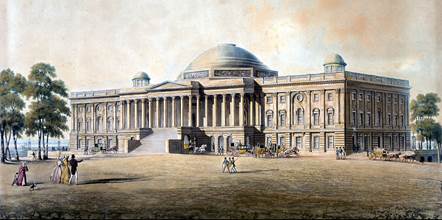The British colonies in North America eventually got fed up with paying taxes to the British Crown without any political representation, making the then-thirteen states of America determined to fight for their independence. They then developed their own constitution from scratch using Enlightenment ideas, including the separation of power, which helped prevent the tyranny of the state. Envisioning a more equal world, the Founding Father Thomas Jefferson, in the Declaration of Independence, confirmed John Locke’s theory of natural rights, declaring that “all men were created equal [and were] endowed by their Creator with certain unalienable rights.” Although imperfect, America became a great success and an example to the world.
The early North American Colonies
The first European explorer after the Vikings to set foot in North America was Giovanni Caboto (c. 1450–1500), an Italian sponsored by King Henry VII of England. Caboto was looking for a Northwest Passage to India, but instead made landfall in Canada in 1497, although no attempts were made to settle there.
Over the course of the 16th century, the Spanish began to expand from South into North America. In 1513, Juan Ponce de Leon (1474–1521) arrived in Florida, which is Spanish for “Land of Flowers”. The Spanish also named other places in North America, including San Francisco, Los Angeles, California, Colorado, and Nevada. In 1585, the English explorer and statesman Sir Walter Raleigh (c. 1552–1618) made the first English attempt to create a permanent settlement in North America, known as the Roanoke Colony in North Carolina, but it was abandoned after conflicts with natives. Raleigh named the American east coast “Virginia,” after the virgin queen Elizabeth (1533–1603). A second attempt at colonization by John White (c. 1539–1593) in 1587 was also unsuccessful.
In 1606, a group of wealthy merchants pooled money together and established the Virginia Company in the hopes of finding silver and gold in the Americas and bringing Christianity to its natives. In 1607, they arrived at Chesapeake Bay, Virginia, on three tiny ships with about 100 men. There, they founded Fort James, which later became Jamestown, named after King James I (1566–1625), who had chartered the expedition. Although with great difficulty, the town managed to persist for the rest of the century. Especially the beginning was tough. Suffering from various diseases, only 38 of the hundred men survived the first year. And since they had little knowledge of farming, they also ran low on food. In an attempt to steal food from the natives, seventeen Englishmen were killed. We are told the Native Americans then stuffed their mouths with corn. Not much later, the native chief Powhatan (c. 1547–1618) changed his mind and offered the starving colony some food, but hostilities resumed soon after. Violence peaked in 1622, when the natives murdered around 350 people, a quarter of the entire colony at that time. Jamestown continued to face food shortages, at one point forcing its inhabitants to resort to cannibalism, but they finally managed to get their finances in order through the sale of tobacco.
Given their poor start, it is understandable that the Virginia Company had trouble finding enough men to populate the settlement. To solve this problem, they handed out free land or a free trip to America in return for a few years of labor. This was even true for prisoners, who could also avoid their sentence by relocating to the colonies. All these men were lured with the promise of a better life—what came to be called the American Dream. To make the trip even more appealing, they were also promised the same civil liberties and rights as the English had at home, which at the time were among the most generous in the world. Starting in 1619, the colony was introduced to another source of labor in the form of slavery when a Dutch ship called the White Lion delivered 20 African slaves, marking the beginning of English involvement in the transatlantic slave trade.
The explorer John Smith (1580–1631) came to lead Jamestown in its second year and managed to restore order to the unruly colony. Smith called his settlers “ten times more fit to spoil a commonwealth than […] to begin one,” yet through strict discipline, he managed to keep the colony alive. [345] At one point, John Smith was about to be executed for trespassing on Powhatan territory, but was saved by Pocahontas (c. 1596–617), the favorite daughter of the chief, who made a plea for his life. She was later kidnapped by the English, but immediately joined them voluntarily. She embraced Christianity, was baptized, was renamed Rebecca, fell in love with an Englishman named John Rolfe, and moved to London with their infant son. Unfortunately, she died there a few months later from lung disease.
Fig. 511 – Pocahontas wearing English clothes, by Simon van de Passe (1616)
At this early stage, the British government showed little interest in its American colonies. Avoiding any financial liability, they generally allowed the colonies to rule themselves. Using this freedom, the Virginia Company established America’s first true legislature in 1619, called the General Assembly, which consisted of the governor and a council appointed by the company back in England. In 1642, this was supplemented with the House of Burgesses, whose members were elected by all male property owners. Like Parliament, the elected assembly controlled taxes and expenditures and held the power to initiate legislation. Similar assemblies would form in later British colonies in North America.
There were also groups of early settlers whose main aim was not profit, but freedom from religious persecution. This was the case for about 100 men, women, and children aboard the tiny ship the Mayflower, who had gained permission from the Virginia Company to settle in Virginia, but who were blown off course and ended up in what would become Boston, Massachusetts. On board were Pilgrims, a group of Calvinist Christians who had broken with the Anglican Church. The Pilgrims came with what they believed to be a divine mission to create a self-governing Christian utopia. They had first fled to the Netherlands, but after ten years concluded it was too worldly. Once in America, the colonists settled in a deserted native village, which they named Plymouth, after the English port from which they set sail. Similar to what happened in Jamestown, the initial years were tough, with half of the settlers dying within a year.
In 1630, the area just north of Plymouth was colonized by the Massachusetts Bay Colony, founded by a group of Calvinist Puritans. They too came to America to found an ideal Christian community. One of its founders, John Winthrop (c. 1587–1649), who assumed close to dictatorial rule over the colony, described their ideal community as “a city upon a hill.” [345] Ironically, the puritans quickly started to persecute any religion other than their own, even leading to executions. One of the settlers, Roger Williams (c. 1603–1683), believed that everyone should have the right to worship God in his own way, including pagans, Jews, Turks, and even anti-Christians. As a result of these beliefs, Winthrop banished Williams, who in time found shelter among the natives. He then bought land from them and established a town called Providence, the first settlement of Rhode Island, and the first in America to allow complete freedom of religion.
Maryland, named after the Catholic wife of King Charles I, was founded in 1634 by Cecilius Calvert (1605–1675) as a refuge for Catholics. As even in Maryland Catholics remained the minority, they decided to protect their faith by issuing the Toleration Act (1649), which gave all Christians the freedom of religion. But when the Puritans managed to take over Maryland, the act was rescinded and in 1692 Catholicism was even banned.
Pennsylvania also has an interesting origin story. It was founded in 1682 by Quakers, a radical group of Christians who believed in religious freedom for everyone and equality of the sexes. William Penn (1644–1718), who had inherited a fortune from his father, was urged by the king to settle in America, as a means of ridding England of Quakers. The land was named Pennsylvania after Penn’s father. William allowed people of different religions to settle there, calling it “a holy experiment” to create a “tolerance settlement” to see if different people could live together in peace. Pennsylvania’s Act for Freedom of Conscience from 1682 declared: “No person […] who shall confess and acknowledge one almighty God to be the creator […] and who professes him or herself obliged in conscience to live peaceably and quietly under the civil government, shall in any case be molested or prejudiced for his or her conscientious persuasion or practice.” [136]
By 1732, a total of 13 colonies had been established along the east coast of America.
Fig. 512 – Navigation by the stars from La cosmographie universelle by Andre Thevet (1575)
No taxation without representation
When the American colonies became profitable, Parliament suddenly became interested, hoping to tax them to finance their war efforts. In 1651, British republican leader Oliver Cromwell passed the first in a series of Navigation Acts, which required the American colonies to only use British ships for import and export, in an attempt to hurt Dutch trade. In 1660, when the British monarchy was back in power, they passed another Navigation Act, which demanded that various products, such as tobacco, could only be exported to either England or its colonies. In 1663, a law was added that required trade ships from Europe to first stop in Britain to be taxed, before they were allowed to continue to America. These acts caused great resentment among the American colonists. In 1678, the Massachusetts legislature declared that the Navigation Acts had no legal standing. As Massachusetts continued to reject British laws, King Charles II, in 1684, revoked the royal charter of Massachusetts. Two years later, King James II turned New England (which at the time included Massachusetts, Connecticut, and Rhode Island) into a single royal super colony called The Dominion of New England. Its population lost its civil rights, they were forced to adopt the Anglican faith, had to pay new taxes, and—of course—were forced to obey the Navigation Acts. In response, the settlers in Boston formed a militia to regain their independence, which they achieved in 1688.
Problems further escalated in 1755, when the British sent a thousand red coat soldiers to America in order to defend the American colonies from France. France, at the time, had taken control of Canada and also the middle of America, which they named Louisiana, after King Louis XIV (1638–1715). At first the colonies appreciated the military backup, but when the soldiers also started to enforce colonial regulations, the colonists started to protest.
In 1756, England and France clashed, unleashing the Seven Years’ War, in which the two superpowers vied for world dominance. The war was fought on four continents and is often considered to be the first true world war in history. The conflict started when the French and the Americans fought over ancestral Native American land in the Ohio Valley. The first shot was fired by none other than George Washington, who confronted the French, but went home defeated. As one British politician claimed: “the volley fired by a young Virginian in the backwoods of America set the world on fire.” When the war ended, Spain gained Louisiana from France and the British took over Canada.
Britain had won the war, but the cost of fighting overseas doubled its debt. To deal with this, they issued new economic regulations on the American colonies, which they felt was only fair, given the amount of money and manpower they had spent on their defense. The Sugar Act lowered tax on sugar to avoid smuggling, but added taxes on other products. The Stamp Act required Americans to purchase stamped paper for newspapers and other purposes and the Quartering Act required Americans to feed and house British troops. This might sound overly controlling, but Parliament didn’t ask for much. In fact, citizens of Britain paid 26 times more in taxes! The greatest complaint of the colonists, however, was not the taxes themselves, but the fact that the British government enforced them without giving them representation in Parliament, as British law required. The conflict divided America into two camps, one in favor of the British monarchy, calling themselves the Loyalists, and another against their presence, calling themselves either Whigs, Patriots, or the Sons of Liberty. The latter group began to produce a flood of pamphlets, speeches, and protests, and famously declared:
No taxation without representation!
The Patriot politician Patrick Henry (1736–1799) convinced the Virginia Assembly to pass the Stamp Act Resolutions which prohibited taxation without representation. The Massachusetts House of Representatives convinced nine colonies to form the Stamp Act Congress, which formulated a Declaration of Rights and Grievances on the matter. Soon after, Patriots began hounding Stamp officers out of office. Finally, Parliament gave in and repealed the Stamp Act. But their debt still needed to be paid off, so in 1767, they issued another act, the Revenue Act, which taxed colonial imports of glass, lead, paint, paper, and tea. Its revenues were used to pay the salaries of royal governors in the colonies. In response, Samuel Adams and James Otis Jr. wrote a letter, soon endorsed by the Massachusetts Assembly, in which they stated that these taxes were illegal. Parliament then dissolved the assembly and sent 3,000 troops into Boston, which the Patriots regarded as an occupation force. The situation soon grew much grimmer. In 1770, a number of Boston Patriots surrounded some British soldiers. When one of the soldiers was pushed to the ground, he fired his musket. In the chaos that followed, known as the Boston Massacre, five people died. As a result of the tragedy, Parliament decided to withdraw its soldiers from Boston, but they did keep patrolling the coast lines.
In 1773, Parliament passed the Tea Act, which allowed the British East India Company, which was in financial trouble, to sell a surplus of eight million kilograms of tea with a reduced tax rate. Protesters who called themselves the Boston Tea Party awaited the tea ships in the Boston Harbor. Some members, disguised as Native Americans, boarded the ships and dumped 342 chests filled with 46 tons of tea into the water, which cost the East India Company an astounding amount of money.
Fig. 513 – The Boston Tea Party throwing tea into the water, by W. Cooper (1789) (Library of Congress, United States)
The British king George III (1738–1820) felt he had no other choice but to intervene by force. Parliament passed the Coercive Acts, also called the Intolerable Acts by the American Patriots, which stripped Massachusetts of its right to self-govern and put them under military rule. They also closed the Boston Harbor until the tea was paid for.
All 13 colonies responded in shock and agreed to form the First Continental Congress, which commenced in Philadelphia in 1774 with the purpose of coordinating their resistance against Britain. This was the first time delegates from all colonies met. The congress supported Massachusetts’s right to resist British tyranny by force, decided to boycott British trade, and petitioned the king of Britain to repeal the Intolerable Acts. The First Continental Congress also adopted a Declaration of American Rights, which rejected the authority of Parliament to regulate colonial affairs. In Virginia, Patrick Henry even declared war was unavoidable, stating: “Give me liberty or give me death” (to which the Loyalists responded: “Treason!”).
Things further escalated in 1775, when the British army in Boston received a secret order to arrest rebel leaders and to seize militia gunpowder that was stored in the city of Concord. But the Patriots found out about the plan. On the way to Concord with about 240 red coats, the British soldiers passed Lexington, where they were confronted by Captain John Parker (1729–1775) and about 70 militiamen. Parker had intended only a silent protest, but when someone fired a shot (it is unclear from which side), the British soldiers shot and charged with their bayonets, leading to eight deaths and ten wounded. The British soldiers then moved on to Concord, where they destroyed the militia supplies, but on their way out of the city they were attacked. Fleeing back to Lexington, they were ambushed multiple times, with three times as many deaths on British side.
After the Battle of Lexington and Concord even ordinary people were determined to fight for the American cause. In the words of Thomas Jefferson, it had unleashed “a frenzy of revenge [among] all ranks of people.” [345]
When the British government did not cave, the Americans organized the Second Continental Congress (1775) with the goal of raising an army to defend themselves against British forces. They placed the army under the leadership of George Washington (1732–1799), a leader with both great courage and composure. The American Revolutionary War (1775–1783) was about to begin.
Thomas Paine
At the start of the war, only a small minority of Patriots wanted true independence. They still considered themselves British subjects and only sought to have their rights restored. But this all changed in 1776, when Thomas Paine (1737–1809), a British emigrant who came to work as a journalist in Philadelphia, wrote a pamphlet called Common Sense. Thomas claimed the Americans should outright abandon the monarchy for its “long and violent abuse of power.” He also rejected the British king’s claim to the divine right to rule. Their ascend to power, he claimed, had been all too human. For instance, had William the Conqueror not been “a French bastard landing with an armed banditti, [who] established himself king of England against the consent of the natives.” Paine also rejected hereditary succession, claiming that “nature disapproves it, [for] otherwise she would not so frequently turn it into ridicule by giving mankind an ass for a lion.” Against the argument that Great Britain had protected the American colonies, he countered that they had only done so “for the sake of trade and dominion” and even pulled America into wars that were not in their interest. On top of all this, it was America and not Britain who had always been “the asylum for the persecuted lovers of civil and religious liberty from every part of Europe. Here have they fled, not from the tender embraces of the mother, but from the cruelty of the monster.”
Then he painted a positive vision of the future characteristic of the Enlightenment, and particularly characteristic of the American consciousness. America, he claimed, had a historic opportunity to “begin the world over again” by designing a government from scratch using Enlightenment principles. “The sun had never shined on a cause of greater worth,” he stated with great conviction.
The cause of America is in great measure the cause of all mankind. Many circumstances had and will arise which are not local, but universal, and through which the principles of all lovers of mankind are affected. [It is] the concern of every man to whom nature has given the power of feeling.
If America would decide to fight for freedom, he continued, they would become “the glory of the earth.” Therefore, it was “time to part” with Britain:
Let none other be heard among us than those of a good citizen, an open and resolute friend, and a virtuous supporter of the RIGHTS OF MANKIND and of the FREE AND INDEPENDENT STATES OF AMERICA.
John Adams would later admit to Thomas Jefferson that “history is to ascribe the American Revolution to Thomas Paine.” Paine’s vision also helped create a strong resolve among the soldiers, which was crucial for winning the war. “Without the pen of Paine,” Adams added, “the sword of Washington would have been wielded in vain.”
The Declaration of Independence
On the second of July, 1776, all colonies at the Continental Congress passed a resolution written by Richard Henry Lee of Virginia, which stated that “these United Colonies are, and of right ought to be, free and independent states.” John Adams predicted that this day would become the most memorable in American history, but it was superseded by an even more important event two days later. On the fourth of July, Congress formally adopted the Declaration of Independence (1776), which is arguably the most important document in world history. The declaration was drafted by the Virginian attorney Thomas Jefferson (1743–1826), one of America’s Founding Fathers, and was then edited by John Adams (1735–1826) and Benjamin Franklin (1706–1790), and then by the other members of Congress.
Fig. 514 – The Declaration of Independence (a copy from 1823)
The Declaration sketched the ideals of a new type of government, deliberately founded on Enlightenment ideals. Thomas Jefferson was especially influenced by John Locke, who believed people have a natural right to consent to their own government and who believed no citizen should harm another in the pursuit of life, health, liberty, or possessions. In the words of Jefferson, this became:
We hold these truths to be self-evident, that all men are created equal, that they are endowed by their Creator with certain unalienable Rights, that among these are Life, Liberty and the pursuit of Happiness. That to secure these rights, Governments are instituted among Men, deriving their just powers from the consent of the governed. That whenever any Form of Government becomes destructive of these ends, it is the Right of the People to alter or to abolish it, and to institute new Government. [346]
Fig. 515 – Thomas Jefferson, by Rembrandt Peale (1800) (White House, United States)
Fig. 516 – Benjamin Franklin, by Joseph-Siffred Duplessis (1785) (National Portrait Gallery, United States)
In the rest of the document, the Founding Fathers outlined a list of grievances against the British crown, highlighting how the British had ignored representative institutions, obstructed justice, kept armies in their midst without their consent, and allowed for taxation without representation. They concluded that King George III had imposed “an absolute tyranny over these states.” As a result, they felt justified in overthrowing British rule, declaring the 13 “United Colonies […] Free and Independent States.”
Fig. 517 – George Washington by Gilbert Stuart (1796) (Clark Art Institute, United States)
Benjamin Franklin and Thomas Jefferson
Benjamin Franklin epitomized the Enlightenment. He owned a print shop where he edited and published the Pennsylvania Gazette, one of the leading newspapers in the colonies. In 1722, when his brother was jailed for three weeks for making satirical remarks about the government, he defiantly reprinted and published Cato’s Letter No. 15 (see the chapter “Consent of the Governed”), which promoted freedom of speech. Later in life, he started a public library, founded an organization that would later become the University of Pennsylvania, and organized a debating club that would later grow into the American Philosophical Society. Benjamin also was an established scientist. He conducted experiments in medicine, meteorology, geology, astronomy, physics, and other fields. Famously, he developed the Franklin stove, the lightning rod, bifocal spectacles, and a glass harmonica. In line with Deism, he questioned the divinity of Jesus, did not believe the Bible was the true word of God, and believed God did not interfere in the world, but was instead the creator of the laws of nature.
Thomas Jefferson was also a quintessential Enlightenment figure. He could read Greek and Latin, became head of the American Philosophical Society, and also became a successful architect (his most famous work being his own mansion, Monticello). As a Deist, he also made his own version of the New Testament, called The Life and Morals of Jesus of Nazareth, from which he cut all miracles and the passages that portrayed Jesus as divine.
The Revolutionary War
The United States had declared independence, but they still had to win a war against Britain, the greatest empire on Earth, with only an improvised army of their own. Washington had hoped for professional soldiers, but he mostly got poor farmers, laborers, and indentured servants who lacked training and had little discipline. George Washington described his army of 19,000 men as “an exceeding[ly] dirty and nasty people,” who did not “know more of a rifle than my horse.” “[The soldiers] come in, you cannot tell how, go, you cannot tell when, and act, you cannot tell where, consume your provisions, exhaust your stores, and leave you at last at a critical moment.” [345] On top of this, Congress was low on cash and still lacked the power to impose taxes on the states. There wasn’t even enough money for matching weapons and outfits (see Fig. 518). Meanwhile, Britain had sent a massive fleet of 427 ships carrying 32,000 troops, the largest seaborn operation the world had seen up until that point.
Fig. 518 – Four of Washington’s soldiers drawn by a French lieutenant, showing from left to right a black soldier freed by joining the military, a New England militiaman, a frontiersman, and a French ally (c. 1781)
The armies first clashed at the Battle of Long Island. The British were victorious, took New York, and chased after George Washington’s remaining forces for two months, covering 270 kilometers, until the colonists were “wearied almost to death.” From this encounter, it became clear that the Americans had little chance on the open battle field, so they instead resorted to surprise attacks. While the British army stayed put for the winter, George Washington, on Christmas night of 1776, had his remaining army of 2400 men cross the icy Delaware River into New Jersey (see Fig. 519), where they performed a surprise attack on 1500 sleeping German soldiers, with only two casualties on their side. The next winter was especially tough, because of the intense cold and the lack of provisions. One soldier later remarked: “We were absolutely, literally starved […] I saw several of the men roast their old shoes and eat them.” [345]
In 1777, America won the three-week-long Battle of Saratoga, surrounding about 6000 British troops. This victory was a turning point in the war, especially as it convinced France that supporting America could hurt Britain, their main competitor.
In that same year, a 19-year-old French orphan named Gilbert du Motier, better known as Marquis de Lafayette (1757–1834) came over from France, excited by the American cause. He served for no pay in exchange for being named a general and soon became one of Washington’s most trusted aides. The same Lafayette would later play a crucial role in the French Revolution.
As the war progressed, it became clear to England that their chances were dwindling. In 1782, Parliament voted for negotiations to end the war. In response, Congress sent a delegation to Paris, which included John Adams, John Jay, and Benjamin Franklin, to discuss the terms for peace. The Treaty of Paris was signed in 1783. It recognized the independence of the 13 colonies of America and also awarded America the territory up to the Mississippi.
Fig. 519 – George Washington passing the Delaware river by Emanuel Leutze (1851) (The MET, United States)
The Constitution
Back in 1776, the Continental Congress had appointed a committee to draft a constitution called The Articles of Confederation and Perpetual Union, which was ratified by all states in 1781. Suspicious of the tendency of governments to devolve into tyranny, they preferred a weak government, with most powers residing with the states. Their first attempt, however, called the Confederation Congress, was far too weak. It had no president, no national court, no national currency, and no power to levy taxes or to enforce any of its resolutions. The only things it could do were handling foreign affairs and solving disputes between states. With such severe limitations, the government was pretty much useless. George Washington had called it “a half-starved, limping government.” [345] As Congress had little money, they couldn’t even pay the army for their service in the Revolutionary War. Understandably, this angered many army officers and some threatened to march on Congress and take control. But luckily, George Washington managed to calm them down. Washington, as the head of the army and with much popular support, could easily have taken over the government, but, instead, he willingly resigned, surrendering the army back to Congress, and returned to Mount Vernon to continue his life as a gentleman planter (reminiscent of the Roman statesman Cincinnatus). For this act alone, King George III, his former adversary, called Washington, “the greatest man in the world.”
As the national government had no money, the states themselves had to pay off the war debt. As a result, taxes were increased. Ironically, most Americans came to pay three times as much in taxes as they had under British “tyranny.”
Article 1 of the United States Constitution established the legislative branch, which consists of Congress and was made responsible for creating laws. Madison proposed the creation of a House of Representatives, elected by eligible voters, and a Senate, elected by the state legislatures (or since 1913, directly by the voters). Madison initially suggested that each state should appoint a number of members to each chamber based on population, but other members of the convention disagreed, fearing this would mean some sparsely populated states would lose their voice. The disagreement was finally resolved by the Great Compromise, which stipulated that each state, regardless of its population, should be equally represented in the Senate. In this way, one house came to represent the states and the other the people. Congress was also granted the power to change the Constitution, but only with at least two-thirds support in both chambers.
Article 2 of the United States Constitution established the executive branch, which centered around the president. The president was made chief of the armed forces, making America more decisive on the world stage, but only Congress could declare war and peace. The president can also veto laws, making him powerful enough to counterbalance Congress, although these vetoes can be overridden if opposed by a two-thirds majority in both houses. As an additional safety mechanism, the president could be impeached by the House of Representatives on charges of treason, bribery, or “other high crimes and misdemeanors,” but could only be removed from office if two-thirds of the Senate voted for conviction. The president was to be elected by a group of electors, called the Electoral College, chosen by the people in local elections. Each state contributed a number of members to the college equal to their representation in both houses. In this way, a president cannot win by appealing to just one part of the country or to just the states with densely populated cities. This forces potential presidents to campaign throughout the entire country and gain the support of a wide range of people.
Finally, Article 3 established the judicial branch, which consists of the federal court system, including the Supreme Court. The judicial branch interprets the laws passed by the legislative branch and ensures every citizen receives equal justice under the law. The Supreme Court has final authority in interpreting the Constitution and settling constitutional disputes between states.
With this setup, the Founding Fathers had created a unique system based on a “new science of politics.” It was a masterpiece, but the country was still young. As a result, there were still doubts. Washington believed the new government wouldn’t “last for more than twenty years.” When the meeting was over Benjamin Franklin remarked: “Gentlemen, you have a republic, if you can keep it.”
George Washington was elected the first president of the United States. John Adams won second place, which made him vice-president. Jefferson came to head the Department of State and Hamilton the Department of Treasury. John Jay became the first chief justice of the Supreme Court.
The Bill of Rights
Over the next few years, the Founding Fathers continued their study of the implications of their new political system. In 1787, Madison, Hamilton, and Jay published the Federalist Papers, which bundled a number of essays which explored the principles embodied in the Constitution. Jefferson called it “the best commentary on the principles of government which ever was written.” Federalist No. 10, written by Madison, became the most influential. It was inspired by the work of the French political thinker Alexis de Tocqueville (1805–1859), who in his Democracy in America had cautioned that in a democracy, a majority could abuse its power and oppress minority groups or individuals. He called this the tyranny of the majority. Madison argued that the size and diversity of America made it impossible for any single faction to form such a dangerous majority, making it “less probable that a majority of the whole will have a common motive to invade the rights of other citizens.”
The politicians during the first presidency were generally divided into two camps. The Federalists, which included Hamilton, Adams, and initially Madison, believed in a relatively strong national government. They were opposed by the Anti-Federalists, who were mainly worried that the new national government would eventually grow corrupt and tyrannical. As a means of preventing this from happening, they proposed adding a Bill of Rights to the constitution to protect individuals and states from the growing power of the national government. Interestingly, Madison eventually switched sides and even came to draft the bill, which was finally ratified in 1789.
The bill added 10 amendments to the constitution. The First Amendment prevented Congress from passing any law prohibiting freedom of speech, the free exercise of religion, the freedom of the press, and peaceful assembly. We read:
Congress shall make no law respecting an establishment of religion, or prohibiting the free exercise thereof; or abridging the freedom of speech, or of the press; or the right of the people peaceably to assemble, and to petition the Government for a redress of grievances. [347]
Madison was satisfied with the First Amendment, stating “the right of freedom of speech is secured; the liberty of the press is expressly declared to be beyond the reach of this Government.”
Interestingly, the First Amendment also prevented the government from taking any stance on religion with the express purpose of protecting religious life from government interference and coercion. According to Thomas Jefferson, it erected a “wall of separation between church and state.”
Slavery and the vote
America’s brilliant system is rightly regarded as one of the greatest inventions of humanity, but its initial version also had some significant flaws which were corrected in later centuries. Although the Constitution confirmed the right to vote and the right to hold public office, this was not immediately available to all citizens. Initially, only a small percentage of the male population was allowed to vote. Universal male suffrage was first achieved in France as late as 1848 (disregarding an earlier short-lived period during the French Revolution). Just 45 years later, the right to vote was first extended to women in New Zealand.
An even graver problem concerned African slaves, who possessed no rights whatsoever. The Constitution had condoned slavery and many of the Founding Fathers, including George Washington and Thomas Jefferson, owned hundreds of slaves. Jefferson’s case was particularly perplexing since he passionately sought to end the practice of slavery by law, calling it “an abominable crime.” He had even added a section to the Declaration of Independence criticizing King George for perpetuating the African slave trade, but the southern colonies demanded that this passage be removed. In his autobiography, Jefferson recognized that “nothing is more certainly written in the book of fate than that these people are to be free.” Yet Jefferson never freed his own slaves, as this would put him at an economic disadvantage. As president, in 1807, he did manage to criminalize the international slave trade (although failing to end slavery itself).
Canada
In 1838, John Lambton (1792–1840), Governor General of British Canada, produced the Durham Report, in which he acknowledged that the grievances of the American colonists had been justified. To prevent similar rebellions in other British colonies, he called for “a system of responsible government [such] as would give the people a real control over its own destinies.” [344] He claimed each colony should have the right to be governed by its own assemblies. In the 1860s, this new ideal was granted to all white colonies. The governor, who worked for the Crown, came to play a more decorative role, while real power came to lie with the representatives in the assemblies. “Responsible government” was hailed as a way of finally reconciling the British Empire with the equally British principle of liberty.
Early American politics
The 1790s saw the first formation of political parties in America. The Democratic-Republican Party was led by Madison and Jefferson, while the Federalist Party was led by Hamilton and Adams. The Democratic-Republicans were mostly southerners who envisioned a rural future for America. They distrusted national government and instead placed their faith in states’ rights and individual freedom. The Federalists came mostly from New England and New York and envisioned a more urban and industrial future for America. They favored a stronger government and were opposed to giving too much power to the uneducated masses. Hamilton even went as far as to speak of the “poison [of] democracy.” The Federalists also saw a greater role for commerce. Alexander Hamilton had been a great admirer of the economist Adam Smith (1723–1790), who had conclusively shown that the prosperity of a country increased if the government limited its control over the economy (we will discuss this in more detail in a later chapter). Using his theories, Hamilton hoped to make America the most prosperous nation on Earth. Following Smith, Hamilton also wanted to quickly pay off the war debts, as this would increase trust in the currency, which would in turn stimulate economic growth. To finance the debt, he sold government bonds, allowing people to own a direct stake in the government. The policy was a success and by 1794, the U.S. had the highest financial credit rating in the world. Hamilton also made plans for a national bank, which came to be known as the Bank of the United States, based in Philadelphia. The bank was granted the power to manage the nation’s money supply by issuing paper currency. It also became a safe place to store federal money and allowed individuals (and also the government itself) to lend money. Madison and Jefferson protested that the creation of a bank was not in the Constitution and feared the bank would give investors control over Congress. This difference of opinion would lead to a vicious feud, especially between Hamilton and Jefferson.
The only person who managed to stay above the infighting was Washington. He had the ability to rise above party differences and kept the country together, earning him a second term. Eventually, however, Jefferson could no longer tolerate Washington’s neutral position and pressured him to pick sides. When he refused, Jefferson resigned from his position (to which John Adams responded: “Good riddance”). Washington would never speak to Jefferson again.
John Adams became the second president of the United States, with his opponent Thomas Jefferson winning the vice presidency. Adams became the first president to live in the White House, located in the new city of Washington in the Federal District of Columbia. Under his presidency, the United States enacted the Sedition Acts which criminalized criticism of the government—in contradiction to the First Amendment. It made it a crime to “write, print, utter or publish […] any false, scandalous and malicious writing or writings against the government of the United States, or either house of the Congress of the United States, or the President of the United States, with intent to defame […] or to bring them […] into contempt or disrepute; or to excite against them […] the hatred of the good people of the United States.” [136] The administration only used the law to prosecute its opponents, while slander on their own side continued unchecked. In 1798, Madison and Jefferson managed to pass a resolution in the legislatures of Virginia and Kentucky to declare the act unconstitutional. Madison agreed that the public sphere could be toxic, but claimed an attack on free speech was a greater danger. If the British had enforced this law, he claimed, America would still be “miserable colonies, groaning under a foreign yoke.” [136]
Jefferson became the third president. In opposition to the more authoritarian Federalists, he presented himself as a man of the people. He opposed fancy parties and clothes and on occasion he even opened the door to his house wearing a robe and slippers. This image wasn’t entirely accurate, however, as he did own an elegant mansion, and had a taste for expensive food, wine, books, artworks, and furniture (in fact, his spending habits would eventually bankrupt him). Once in office, Jefferson restored freedom of speech. In his first inaugural address, he wrote that “error of opinion may be tolerated, where reason is left free to combat it.” As expected, this quickly made him the target of horrible newspaper smear campaigns. Jefferson did pursue a few libel cases himself, but in general made no effort to target political enemies with sedition charges as his predecessor had done.
Interestingly, Jefferson did continue Hamilton’s economic program, including the national bank he had previously opposed, as he came to recognize its value. Under his watch, America also bought Louisiana from Napoleon. To study the new terrain, Jefferson established a scientific expedition under the leadership of Meriwether Lewis (1774–1809) and William Clark (1770–1838). They traveled through the rugged wilderness of Middle America and eventually even reached the Pacific.
Meanwhile, Hamilton was challenged to a duel by a political opponent. Hamilton fired the first shot, but intentionally missed as a demonstration of his moral principles. His opponent, however, had no such reservations and shot him. He died the next day.
The next President was Madison, who instigated the War of 1812 against the British in Canada, as they had been supporting Native American resistance at the American frontier. The war didn’t start well for America. When their troops entered Canada, they were crushed. In one instance, an entire regiment of 2500 soldiers surrendered without firing a single shot. Britain then invaded the United States. They even managed to capture Washington DC, where they burned down the White House, the Capitol Building, and the Library of Congress. Madison fled just in time, bringing with him a painting of George Washington and a copy of the Declaration of Independence.
As a result of the failure of the initial war effort, Madison received much criticism, but when the war finally turned in America’s favor, he was hailed as a hero. The Federalists, who had opposed the war, were branded as disloyal causing the party to implode.
Although generally preferring a small government, the war did convince Madison that the nation needed a stronger army. He did allow the charter of the national bank to expire in line with his principles, but when this led to economic chaos, he made up his mind and quickly instituted the Second Bank of the United States.
Fig. 521 – The original Capitol building
designed by Benjamin Henry Latrobe before it was burned. (Thomas Sutherland,
1825)
TABLE OF CONTENT

